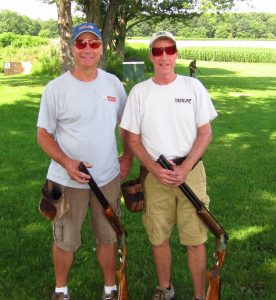Tune-Up with clays
While bird hunting last fall, I found I couldn’t hit the broad side of an extremely large barn. I’m talking point blank mallard ducks locked up over the decoys at thirty yards, flushing pheasants at twenty-five yards and, worst yet, hovering Canadian geese so close I could smell the corn on their breath. Much of this was due to my rusty old reflexes and worsening eye sight, but still unacceptable.
After missing too many hard-worked-for opportunities in the field, I promised myself that in the off season I would join a gun club and practice throughout the summer, something I’d never before felt I had to do in my half century of shooting a shotgun.

Unsure which club to join, I contacted an old friend, Pat Breen. Pat is a veteran of thirty plus years skeet shooting and has learned from the best. When Breen was in his early thirties, Harold Contant took him under his wing and showed him how to break clay targets consistently. Harold Contant of Palmyra was a legend in the skeet shooting world during the 60’s and 70’s, winning numerous New York State titles, national high average leader, was named to multiple All-American teams and a New York State and National Skeet Shooting Association Hall of Fame inductee.
Now fast forward to present time, Pat shoots alongside some of the best in the country such as George Lehr and Craig Parsons. Breen shoots on a skeet team for the Newark Gun Club with Craig Parsons, who is another Hall of Fame skeet shooter and one of Pat’s close friends. Parsons has won over 40 New York State titles, three world championship titles, and was inducted into the National Skeet Shooting Hall of Fame in 2010. The list of Craig’s accomplishments in the skeet shooting world could fill this column.
Pat is a high caliber skeet shooter in his own right, but to speak with him you would never know it. His humble nature is one of my good friend’s many great qualities. Pat emphasized that he has been honored to shoot with these elite gentlemen over many years. Breen’s background along with the current company he keeps makes him a gold mine of clay shooting knowledge and I planned to mine that gold.
The first fact Pat laid on me was that in a sixty-mile radius of Rochester, there are 60 plus clubs where you can shoot skeet, trap, five-stand, sporting clays or rifle/pistols, so there are plenty to choose from (wheretoshoot.org).
I asked him what clay game should I shoot to revive my corroding wingshooting skills and he explained, “Shoot any of the clay sports and they will help you to be a better wing shot, but if you want to practice for hunting, shoot sporting clays or five-stand. They will give you a better cross section of shots you’re most likely to encounter while hunting. Skeet and trap are great and will get you comfortable with the basics of tracking, leading, following through and swinging the gun; but the disciplines are much different.
“Most clubs have nonmember prices and will welcome you to try their facilities, and some may even send a member with you the first time. There are a lot of knowledgeable and friendly shooters out there at the various clubs and you can learn a lot from watching the good ones shoot. Most will gladly share their knowledge and help you along the way. You just need to take those first steps to get out there and shoot.”
Sporting clays is what I need to shoot. Now how do I hit them? I asked Pat for the shooting tip he thought was the most important. He quickly replied, “Try your best to get a shotgun that fits you. The way to know if it fits is to mount the gun quickly to your cheek. You should be able to see straight down the barrel or the vent rib without repositioning your head. If it doesn’t, your fit is poor. Many shooters have a gun that points low due to bad fit and this causes them to lift their head off the stock to see down the barrel, resulting in inconsistency hitting the target. One thing all the good shooters have in common is that their stocks fit them. Many have adjustable combs or pads on their stocks so their eye is aligned with the rib when the gun is mounted. Once you join a club, there will be members glad to help you with stock fit.”
Pat pointed out an exciting development in the shooting world. New York State last year began with the inaugural season for the New York State High School Clay Target League. Last year saw roughly five teams with 125 student athletes shooting trap after school and this spring the league grew to more than 370 students on 19 teams at various gun clubs. Locally, Pal–Mac had a five-person team shooting at Newark Gun Club (nyclaytarget.com).
After input from Mr. Breen, I decided to join Rochester Brooks Gun Club, (rochesterbrooks.org) primarily because they have two great sporting clays courses. Brooks has been around since 1963 and is the largest club in Western New York. They have 14 skeet fields and 14 traps, three of which are lit for night shooting. They also have a heated five-stand range and two different sporting clays courses, not to mention eight pistol bays and 50, 100- and 200-yard ranges.
Before joining, Rochester Brooks requires all new members to attend a four-hour safety course. There is an annual membership fee of $250 that helps pay to keep the club in tip top condition.
I have shot sporting clays several times now since I’ve joined Rochester Brooks and I’ve been pleasantly surprised by what a great social game it is. Like golf, you walk the course with friends and rib each other as you move from station to station.
After several rounds of practice, I’m happy to report I can once again hit the side of any extremely large barn. By the time hunting season arrives I hope to work my way up to an extremely large shed.
If you need a tune-up like me or just plain like to shoot, give any of the shooting sports a try. It’s easier than you think to get started.





